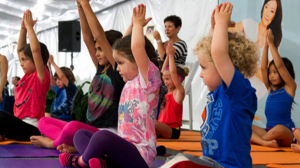What yoga pose will make this kid listen?
Embodied Education
 Thanks to a new study getting fabulous publicity, yoga is making its way into classrooms everywhere. At Mind Body Health Associates, we’ve long recognized the importance of bringing the body into the educational setting because of the way it is intimately connected to our brains. Children, especially, need their whole body to be engaged for maximum learning to occur.
Thanks to a new study getting fabulous publicity, yoga is making its way into classrooms everywhere. At Mind Body Health Associates, we’ve long recognized the importance of bringing the body into the educational setting because of the way it is intimately connected to our brains. Children, especially, need their whole body to be engaged for maximum learning to occur.
Our in-house yoga instructor, Michele Minehart, has worked with school districts offering yoga as part of their professional development, both as an experiential practice and as interventions for test anxiety. Education is eager to implement these simple tools that utilize the power of mindfulness. You don’t need to get your RYT 200© certification to reap the benefits of helping kids move their bodies and pay attention to their breath. If you’re looking to add a few tools to the toolbox, here are some suggestions:
- Start with breathing. Ask your kids to take a big breath before starting the next activity. Our classrooms are filled with hurry and taking a brief moment in the transition will help them to fully arrive at the next activity.
- Give it only 2 minutes. Let go of ideas that you need to devote an hour of classroom time to yet another thing. Science says that 60-90 seconds is all that is required to return an activated stress response (fight or flight) to one that is ready to learn. A few deep breaths with arm movement followed by a standing forward fold, or a balancing pose on a day you feel fancy, is plenty for them to begin.
- Name your targeted outcome. You’re probably not looking for kids to be able to wrap a leg around their neck. What are you looking for when you institute some form of classroom yoga? One of the most noticeable benefits is behavior change, specifically in the realm of self-regulation. You can create a habit with the children to take a deep breath when they’re angry before responding by practicing taking a deep breath while they’re not angry; over time the habit will develop.
- Remember: Where the attention goes, the energy flows. Some kids may not like the classroom yoga because new things are frequently scary things (this is the body’s protective reaction). You could meet reticence. That’s okay. Don’t use your energy trying to convince the apprehensive students. Instead, direct your attention to the ones who are participating and appreciating the experience. Success is the best PR, and the kids who are more slow to adapt will eventually want to join along.
- Practice what you preach. You don’t need to join a fancy studio, but you can intentionally find ways to mindfully move your body. Walks in nature and running are great alternatives, especially if you already have a practice. A home yoga practice can be led via youtube or free apps (Michele recommends Down Dog; therapist and yoga instructor Rachel Tincher loves the practices available on Amazon’s Audible).
Kids have a BS sniffer and can sense if you don’t believe what you’re saying. Integrate the idea of moving your body as you notice your breath and the present moment so that you can teach the tools with honesty and integrity.
